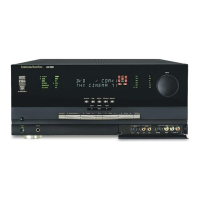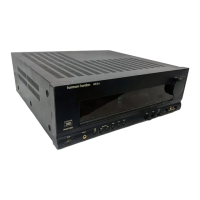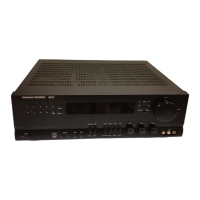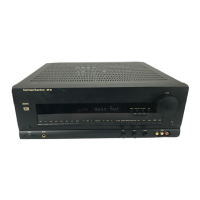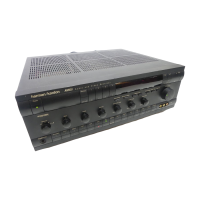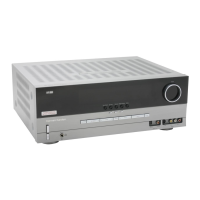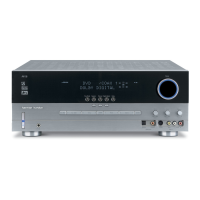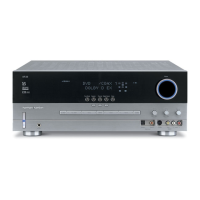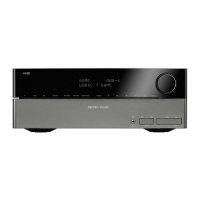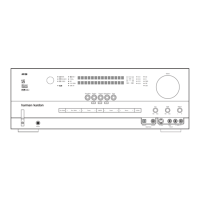Do you have a question about the Harman Kardon AVR 8500 and is the answer not in the manual?
| Brand | Harman Kardon |
|---|---|
| Model | AVR 8500 |
| Category | Receiver |
| Language | English |
Product complies with specified technical standards for safety and performance.
Details of the manufacturer and their European branch.
Explains formatting like bold, italics, and symbols used in the manual.
Highlights key capabilities and technologies of the AVR 8500.
Critical warnings regarding voltage, power cords, and cabinet safety.
Advice on proper placement for ventilation, stability, and environmental conditions.
Instructions for safe cleaning and handling of the unit.
Cautions about electrical shock risks and referencing qualified personnel.
Explains the main power switch and system power control functions.
Details the headphone jack and various input selection buttons.
Explains buttons for selecting Dolby, THX, and Logic 7 surround modes.
Describes Tone Mode, DSP Surround Mode Selector, and Tuning Selector functions.
Explains tuner band, 6/8-channel direct, preset selection, and input source buttons.
Details RDS, DTS Neo:6 selectors, digital select, volume control, and various indicators.
Explains the Upper and Lower Display Lines and their messages.
Details the meaning of various indicator lights on the front panel.
Describes indicators showing speaker configuration and input channels.
Details analog audio inputs/outputs and speaker terminals.
Explains digital audio inputs/outputs and various video connections.
Describes antenna inputs and remote IR connections.
Explains connections for external amplifiers and video monitoring.
Details connections for front, center, and surround speakers with color coding.
Explains coaxial and optical digital audio connections for recorders and sources.
Explains core remote functions like power, input selection, and AVR switching.
Details buttons for tuner operation and various surround modes.
Covers buttons for menu navigation, digital selection, and setup.
Details power on/off and how input selectors change device control.
Explains tuner select, surround mode select, and test tone functions.
Describes navigation buttons, set button, and digital input selection.
Explains numeric keys for presets and tuner functions.
Details how to select Dolby, DTS, Logic 7, and DSP surround modes.
Covers macro programming, RDS selection, and preset tuning.
Explains speaker select and multi-room activation buttons.
Details volume control, SPL indicator, and remote learning functions.
Explains tone mode adjustment and THX processing selection.
Explains power, AVR select, and input selection for the Zone II remote.
Details tuner select, tuning, record/pause, and playback functions.
Covers preset skip, volume control, mute, and disc skip for Zone II.
Instructions for connecting CD players, tape decks, and digital sources.
Guidance on connecting speakers and observing polarity.
Instructions for connecting VCRs, satellite receivers, and DVD players.
Details connecting video signals and notes on format conversion.
Explains using SCART to Cinch adapters for European devices.
Specific advice on connecting S-Video devices to avoid signal issues.
Illustrates various SCART adapter setups for playback and recording.
Explains SCART control signals and RGB signal routing through the AVR.
Explains connecting remote sensors and multiroom IR links.
Details trigger connections for external amps and accessory outlets.
Guidance on connecting external amplifiers and AC power requirements.
Advice on choosing matching front speakers for a cohesive soundstage.
Guidance on positioning front, center, surround, and subwoofer speakers.
Steps for initial power-up, remote setup, and display checks.
Explains how to use the on-screen menus for configuration.
How to set parameters individually for each input source.
Guides on selecting digital or analog inputs for each source.
How to switch front panel jacks between input and output modes.
How to adjust bass and treble settings via menu or remote.
Explains global tone control adjustment via front panel or OSD.
How to access and navigate the speaker setup menu.
Steps to set front left/right speakers to Large, Small, or None.
Guides on configuring center and surround speaker settings.
Steps to configure subwoofer and set crossover frequencies.
Explains icons indicating speaker setup status.
How to access and navigate the surround select menu.
How to select and apply THX post-processing to surround modes.
Explains how THX menus vary based on system configuration.
Details selecting modes within Dolby, DTS, Logic 7, DSP, and Stereo categories.
How to configure settings for inputs not yet adjusted.
How to synchronize speaker timing based on listening position.
Setting Dolby Digital Night Mode for dynamic range preservation.
Importance of output level adjustment for surround sound clarity.
Step-by-step guide to using EzSet for automatic speaker level calibration.
How to manually adjust output levels using the CHANNEL ADJUST menu.
Using test noise to equalize speaker output levels.
Adjusting levels using playback signals or the SPL indicator.
How to set the limiter to protect the subwoofer from excessive levels.
Concludes setup and points to advanced settings.
Introduces a chart detailing various surround modes and their features.
Explains Dolby Digital Surround EX and THX processing modes.
Details Dolby Digital and DTS 5.1 surround modes and their features.
Explains Logic 7, DTS Neo:6, and Dolby 3 Stereo surround modes.
Describes Theater, Hall 1/2, and VMAX (Near/Far) surround modes.
Explains 5/7-Channel Stereo and Surround Off modes.
Instructions for powering the unit on/off and using the sleep timer.
How to select audio/video sources and manage inputs.
Details volume control, muting, tone controls, and headphone jack usage.
Guidance on selecting modes for CDs, movies, and TV based on source material.
How to activate THX modes and important notes regarding their use.
Overview of digital audio formats like Dolby Digital, DTS, and PCM.
Details Dolby Digital and DTS audio formats, including Surround EX.
Explains PCM audio and HDCD decoding capabilities.
Information on playing MP3 audio files through the AVR.
Notes on MP3 compatibility and digital output signals.
How to connect and select digital sources like DVD, CD, and HDTV.
Details indicators for Dolby Digital, DTS, PCM, and HDCD signals.
Explains indicators for digital signal reception and interruptions.
How to use the Night Mode for Dolby Digital sources.
Key considerations for digital playback, compatibility, and recording.
How to record audio/video signals to tape or digital recorders.
Steps to switch front panel Video 5 jacks between input and output.
Adjusting output levels using source signals or test tones.
Using external test signals or the AVR's test tone for level adjustment.
How to use direct inputs for external multi-channel sources.
Explains the memory backup system for settings and presets.
How to reset speaker configuration to default factory settings.
How to adjust or turn off the display brightness.
How to set a default volume level for when the AVR is turned on.
How to enable, disable, or adjust the time for semi-OSD displays.
How to adjust the duration the full OSD menus remain on screen.
Overview of installing a multiroom system with IR sensors and speakers.
Steps to configure multiroom system using OSD menus.
How to control the multiroom system from a remote room.
How to tune AM/FM stations manually or automatically.
Steps for storing and recalling preset radio stations.
How to cycle through RDS data like call sign, PTY, and text.
How to search for stations based on program type (PTY).
Method for programming remote codes directly from tables.
Using auto-search to find codes when direct entry fails.
How to read entered codes and learn from other remotes.
Steps to erase single or all learned codes from the remote.
How to erase all codes or macros from the remote.
How to create and program macro command sequences.
How to use the remote for devices other than the AVR.
Configuring volume control to work with the AVR or TV.
How to control channels of another device while using the AVR.
How to control playback functions of other devices.
How to reassign input selector buttons to control different devices.
Steps to reset the remote to its original factory settings.
Lists functions of remote buttons 1-44 for AVR, DVD, and CD/CDR.
Lists functions of remote buttons 45-71 for AVR, DVD, and CD/CDR.
Maps remote buttons to functions for Tape, VCR, TV, CBL, and SAT devices.
Addresses issues like no power, no sound, display problems, and remote response.
Steps to reset the AVR's memory and configuration.
Details power output, sensitivity, distortion, and tuner ranges.
Covers video formats, power requirements, dimensions, and weight.

